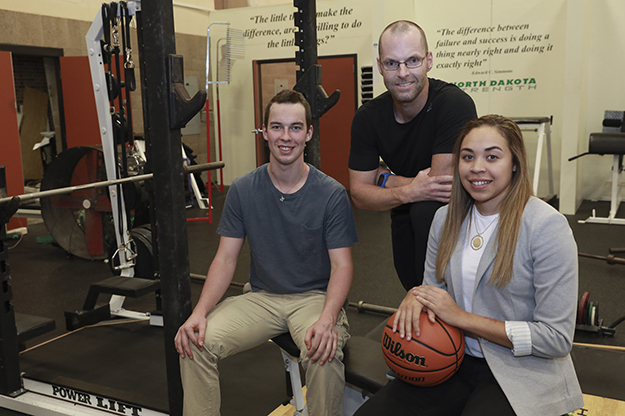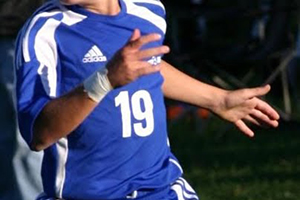It’s all in the hands
World-renowned UND kinesiologist joins grad student and own son in studies linking finger length to strength, athleticism

Examine your fingers. Which is longer – the index finger or the ring finger?
And can a difference in digits predict athletic ability? Grant Tomkinson, professor of kinesiology and public health education, decided to find out.
Tomkinson conducted separate research studies with his master’s student, Makailah Dyer, former UND Fighting Hawks women’s basketball standout, and his son, Jordan, a senior and basketball player at Sacred Heart School in East Grand Forks.
Males typically have longer ring fingers than index fingers, or a lower digit ratio, than females, whose fingers are about the same length.
Though the relationship between digit ratio and athletic performance is generally stronger in males, important relationships have been found in females.
Dyer looked at digit ratio in semi-pro women basketball players in Australia.
“There is a favorable correlation between digit ratio and semi-pro women basketball players,” Dyer said. “If the fourth finger is longer than the second, you tend to be better at basketball, especially defensively.”
There is some indirect evidence, said Tomkinson, that the digit ratio is determined during early fetal development – as early as the second trimester of pregnancy – by the balance between the steroid hormones testosterone and estrogen. The developing ring finger has a high number of receptors for testosterone: the more testosterone the fetus produces, the longer the ring finger, and so the lower the digit ratio.
The digit ratio points to prenatal events that link with athletic performance, Dyer said.
“I was surprised – digit ratio is not something you’d normally look at,” she said. “It’s amazing. You can look at someone’s hand and potentially predict their athletic ability.”
Her work is under review by the American Journal of Human Biology.

Ahead of the game
Tomkinson said he encourages his students to publish their work.
“I hate seeing theses only bound and on a bookshelf,” Tomkinson said. “I want to help students publish so they’ll be ahead of the game. All my master’s students submit for publication and then finish their thesis.”
Tomkinson, who studies childhood obesity, physical activity and fitness, said he’s also interested in the quirky.
That interest in the road less traveled attracted his son, Jordan, to do research for his science fair project.
“My dad overheard me talking about what to do for the science fair, and he suggested I do something with digit ratio,” Jordan said. “I was hooked as soon as he started talking about it.”
Jordan measured the digit ratios of 57 male classmates at Sacred Heart.
“The hardest part was getting all the parents to sign consent forms,” he said. Then he tested the grip strength of his classmates, and analyzed the data.
“The length of the fourth finger compared to the second finger determines how strong you currently are and how much testosterone you were exposed to in the womb,” said Jordan. “Those with a longer fourth finger were stronger, even when we controlled for age and body size.”
Jordan’s science fair project took second place, and his dad suggested that Jordan publish his work.
It’s in the October 2017 issue of The Journal of Early Human Development.
Standing out
“It’s all about trying to stand out and doing the extras,” said Tomkinson. “This is a high-level extra that will help him with college admissions and post-graduate work.”
“I’m glad to be part of this and glad my name is on a published paper,” said Jordan, who hopes to continue to play basketball, major in physical therapy, and earn his doctorate.
The research has already garnered attention in Tomkinson’s native Australia, and is gaining momentum in the U.S. For more, see here.
Beyond the quirky, there’s a question that goes beyond fun and games, said Tomkinson. Human development is dependent on genetics and environment.
“Between genetics and environment is the mother’s womb, a critical growth period,” Tomkinson said, adding that an expectant mother with healthy behaviors has a healthier baby.
“Good growth and development in the womb bodes well for not only athletic performance but also good health,” Tomkinson said.
The long and short of it? Sporting success is in your hands.


